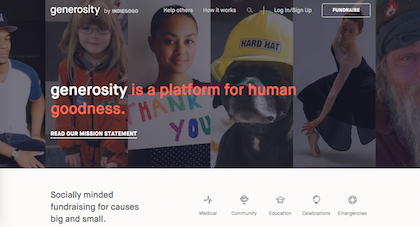Having raised $23 million in series B funding from Andreessen Horowitz in late 2013, recently released their open source crowdfunding platform, CrowdtiltOpen, and announced that they are expanding into NYC “from crowdfunded events to group fundraisers,” this young startup is becoming a competitor to be reckoned with for the well known Kickstarter, Indiegogo, and other fundraising sites.
So how does Crowdtilt compare? What’s the difference between Crowdtilt vs. Kickstarter vs. Indiegogo and the slew other other crowdfunding sites that are emerging covering niches like real estate, equity crowdfunding, and more.
Who should use Crowdtilt?
According to CEO/Co-Founder James Beshara, “There’s 85% of the population that won’t have a documentary, an artistic project or a hardware project to crowdfund, but they’re going to have an objective that they do want to send around to their friends and their network…That’s where Crowdtilt was born.”
 Up until this point, Crowdtilt has described itself as a way for family and friends to pool funds for events, causes, and group purchases like “wedding gifts” and “tickets to the game.”
Up until this point, Crowdtilt has described itself as a way for family and friends to pool funds for events, causes, and group purchases like “wedding gifts” and “tickets to the game.”
Notably, the platform has also been used to raise money for civic crowdfunding projects like when users raised over $20,000 for a to help their local community combat crime .
Although Beshara says the average successful Crowdtilt campaign raises $1,320, there have also been smash-hits on the Crowdtilt platform like when the Jamaican Bobsled team raised $129,687.17 get to Sochi ($30,000 in donations from 1,600 members of the Dogecoin cryptocurrency community).
In addition, larger brands like Soylent, a nutrition supplement company, have used CrowdtiltOpen, Crowdtilt’s open-source DIY white-label crowdfunding solution, to bring their nutritional food-drink to life. The company collected over $2.1M from over 20,000 supporters.
What are the differences in fees?
As an all-or-nothing crowdfunding platform, if a fundraising campaign is successful (or “tilts”), Crowdtilt takes a fee of 2.5 percent of the money raised (5% for “Sell Something” campaigns). You should also expect to pay a 2.5% credit card processing cost (there’s no fee for “Sell Something” campaigns.)
In comparison, Kickstarter takes a 5% fee of money raised if the users’s campaign is successful and Indiegogo takes a 4% fee if you reach your goal (these numbers do not include credit card fees. For Kickstarter, Amazon will apply credit card processing fees between 3-5% and for Indiegogo, you can expect 3% for credit card processing plus a $25 wire fee for non-U.S. campaigns. Currency exchange fees may also apply.).
If you are doing a flexible funding campaign and do not reach your goal on Indiegogo, the platform takes an overall 9% fee. If you are doing a fixed funding campaign on Indiegogo and do no reach your fundraising goal, you would simply not receive any funds.
In my experience, I’ve seen a 5% fee as the industry average across crowdfunding platforms. However, some niche crowdfunding platforms charge upwards of 7% or 8% funds raised. Crowdtilt definitely comes in at below the industry average.
What’s the deal with CrowdtiltOpen and CrowdHoster?
CrowdtiltOpen is essentially a rebranded and relaunched version of CrowdHoster. It allows you to create and customize a self-hosted crowdfunding campaign.
No coding knowledge is required. However, if you want to fully customize the look-and-feel of your campaign, you would need to do so expanding on or replacing the standard CSS.
CrowdtiltOpen is free to use, allows you to accept pre-orders after a campaign has finished, integrates with BackerKit, and even has recurring billing options.
It’s a formidable alternative to other white-label self-hosted crowdfunding tools.
What are the campaign stats like on CrowdTilt?
A 2012 VentureBeat article reported that, “86% of [Crowdtilt] campaigns are successful, and on average, raise almost twice as much as they need to tilt. Campaigns that reach a 34% of their goal have a 99% chance of going all the way, and 38% of activity happens in the last few hours.”
According this recent TechCrunch article, from their launch in February of 2012 to December 2013, the company has run over 100,000 campaigns across all its products, and while Beshara declines to saying how much it has seen in transactions, he says that the average campaign raises 192% of its target.
In addition, Beshara says the average successful Crowdtilt campaign raises $1,320.
So why should I use CrowdTilt over other platforms?
“The company, to some extent, competes with sites like Kickstarter or Indiegogo, for example, but found a niche for itself in helping everyday users crowdfund smaller projects, often with a more community-oriented nature.” – Source.
If you’re looking to pool funds for an event, small fundraiser, community project, or raise money from friends/family for a charity cause, I think Crowdtilt is a great solution.
For small campaigns that primarily draw from your social network, you will be doing most of the legwork to get supporters. Seeing as CrowdTilt charges a 2.5% fee as opposed to GoFundMe’s 5% fee and FundAnything’s 5%-9% fee, the solution is pretty apparent.
If you’re going to be crowdfunding a product, game, or other type of creative project, I would still recommend going the traditional route via Kickstarter, Indiegogo, RocketHub, or other project crowdfunding platform.
If you have a large following or an established business with repeat customers, the CrowdtiltOpen platform is definitely something worth looking into.
One huge plus of a self-hosted campaign is that you can easily integrate google analytics and do A/B testing.
Alternatively, you could also install google analytics on a landing page for your crowdfunding campaign on Kickstarter or Indiegogo.
My Question For You!
1. Was this article helpful?
2. What do you think of Crowdtilt?
Leave a comment below.






